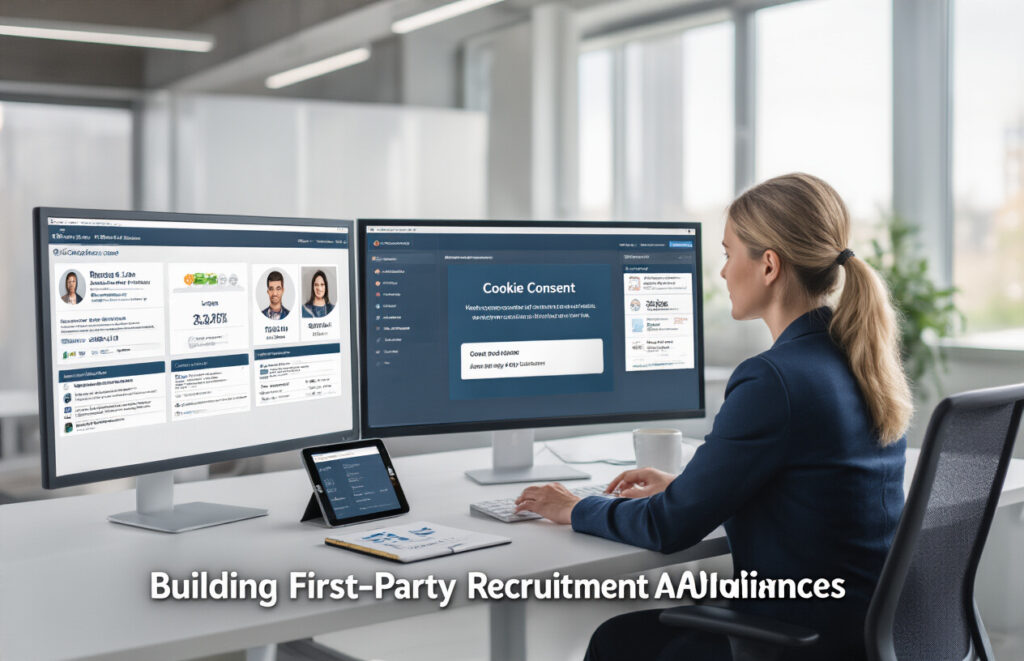Third‑Party Cookie Sunset: Building First‑Party Audiences for Job‑Ad Retargeting

Remember the panic when Chrome announced the cookie apocalypse? Recruitment marketers everywhere scrambled like ants at a picnic that just got rained on.
But here’s the thing – third-party cookie deprecation isn’t the end of your recruitment advertising strategy. It’s just the beginning of something better.
The most innovative talent acquisition teams are already pivoting to first-party audience strategies for job-ad retargeting. They’re building direct relationships with candidates instead of relying on borrowed data that’s about to disappear.
What if you could improve your recruitment marketing performance while everyone else is freaking out about cookies? The companies that get this right aren’t just surviving the change – they’re thriving because of it.
But how exactly are they pulling this off?
Understanding the Third-Party Cookie Sunset

A. The timeline for third-party cookie deprecation
Google’s been playing the “will they, won’t they” game with third-party cookie deprecation for years now. Initially announced in 2020, the sunset has been pushed back multiple times. But now it’s happening—Google started phasing out cookies for 1% of Chrome users in January 2024, with complete deprecation expected by the end of 2024.
Other browsers like Safari and Firefox already block third-party cookies by default. Chrome’s the big domino, though, with about 65% of the global browser market share. When Chromo completely turns off the cookie-based ad targeting world, it effectively ends.
B. Impact recruitment marketing strategies
Recruitment marketers are in a tough spot right now. Those fancy retargeting campaigns that followed job seekers around the internet after they visited your careers page? They’re about to stop working.
This isn’t just a minor inconvenience—it’s a fundamental shift. Without third-party cookies, you can’t:
- Track candidates across multiple sites
- Build behavioral profiles of potential applicants
- Serve targeted job ads to people who’ve shown interest but didn’t apply
- Accurately measure cross-site campaign performance
Talent acquisition teams relying on cookie-based strategies are facing a severe disruption to their candidate pipelines.
C. Why job-ad retargeting requires a new approach
Job hunting is different from regular shopping. People don’t buy jobs impulsively—they research, compare, and consider before applying. This makes retargeting especially valuable in recruitment.
The traditional approach of dropping a pixel on your careers site and then chasing candidates online is dying. Privacy regulations like GDPR and CCPA were already making this problematic, but cookie deprecation delivers the knockout punch.
The old “spray and pray” method of blasting job ads everywhere won’t cut it anymore. Recruitment costs are rising, and without targeting, you’ll waste budget reaching people who aren’t even looking for jobs.
D. First-party data as the new recruitment marketing currency
First-party data is gold in the post-cookie world. This is information people willingly share with you—email addresses, job preferences, skills, and career interests.
Savvy recruiters are already building these direct relationships. They’re creating talent communities, offering job alerts, hosting virtual events, and providing valuable career content—all to collect first-party data with proper consent.
With this information, you can create segmented audiences and activate them across channels without relying on third-party cookies. Email nurturing, SMS campaigns, and walled garden platforms (like LinkedIn, Facebook, and Google) all work with first-party data.
The companies building these audiences now will have a massive competitive advantage when cookies finally crumble. They’ll maintain targeting capabilities while their competitors scramble to adapt.
Building First-Party Data Strategies

A. Defining valuable candidate data points
When cookies crumble, what’s left in your talent acquisition toolbox? First-party data – the gold you mine directly from candidates who engage with your brand.
Savvy recruiters focus on collecting data points that matter:
- Behavioral signals: Which job categories are they browsing? How much time do they spend on specific listings? Are they returning visitors?
- Career progression markers: Current role, years of experience, skill proficiency levels, and career aspirations
- Engagement preferences: Do they prefer email updates or text alerts? Morning or evening communications? Technical deep-dives or culture-focused content?
- Application triggers: What finally convinced them to hit “apply”? Was it a salary range, flexible work options, or development opportunities?
The beauty of this approach? Quality trumps quantity every time. Ten data points that help personalize a candidate’s experience are infinitely more valuable than 100 random facts collecting digital dust in your ATS.
B. Creating value exchanges to collect candidate information
Nobody gives away their info for nothing these days. And they shouldn’t.
The transaction is simple: give candidates something worthwhile, and they’ll happily share relevant data. But what counts as “worthwhile”?
- Exclusive content: Salary guides, interview prep resources, or industry trend reports
- Personalized job matches: “Share your preferences, we’ll send only relevant roles.”
- Learning opportunities: Webinars, skill assessments, or certification pathways
- Community access: Networking events, mentorship programs, or insider forums
A talent community newsletter with genuinely helpful content gets 5x the engagement of generic job alerts. Why? Because it’s not just another notification – it’s useful.
The best exchanges feel less like “data collection” and more like “we’re getting to know each other.”
C. Implementing transparent data collection on career sites
Sneaky data collection is out. Transparency is in.
Your career site should make it crystal clear:
- What information are you collecting
- Why do you need it
- How will you use it
- How long will you keep it
Progressive disclosure works wonders here. Don’t ask for everything up front. Start with basics (name, email) and gradually collect more as the relationship develops.
Smart implementation looks like:
- Prominently displayed privacy policies in plain English (not legalese)
- Contextual explanations next to form fields (“We ask for your location to show you nearby opportunities”)
- Preference centers that give candidates control
- Confirmation messages that reinforce the value (“Thanks! We’ll send 2-3 relevant jobs weekly”)
When candidates understand the “why” behind your requests, opt-in rates jump dramatically.
D. Leveraging application form insights ethically
Application forms are data goldmines, but with great data comes great responsibility.
The ethical approach:
- Ask only what’s necessary for the current stage
- Explain why specific fields are required
- Use conditional logic to minimize form fatigue
- Analyze completion rates to identify friction points
- Apply insights to improve the candidate experience
For example, if 70% of candidates abandon your application when you ask for references too early, that’s valuable intelligence. Move that section later, or explain why you need it now.
Transform application insights into action by:
- Creating segmented talent pools based on skills and interests
- Developing targeted content that addresses specific candidate needs
- Personalizing follow-up communications
- Identifying and removing barriers in your hiring process
The most powerful insights often come from what candidates don’t do rather than what they do.
E. Building talent communities that generate ongoing data
One-time applications give you snapshot data. Talent communities provide the whole feature film.
The best communities:
- Deliver consistent value (not just job postings)
- Create two-way conversations
- Foster peer-to-peer connections
- Continuously refresh member preferences
A thriving talent community becomes a renewable resource for first-party data, revealing how candidate interests evolve.
Structure your community to capture nuanced data through:
- Polls and surveys that feel engaging, not intrusive
- Content preference signals (clicks, shares, time spent)
- Optional profile enhancements (“Update your profile to get more personalized recommendations”)
- Community participation patterns
Remember: Communities thrive on reciprocity. For every piece of data you collect, provide something of equal or greater value in return.
Technology Solutions for First-Party Audience Building

A. Candidate relationship management systems are worth investing in
The cookie apocalypse is here, and savvy recruiters are pivoting fast. Your CRM is now your recruitment goldmine – but not all systems are created equal.
Top-tier CRMs like Beamery, Avature, and Phenom People aren’t just contact databases anymore. They’re sophisticated engines that help you build, segment, and activate first-party talent pools without relying on third-party cookies.
What makes a CRM worth the investment? Look for these features:
- Personalized candidate journeys that adapt based on behavior
- Custom audience segmentation that rivals marketing platforms
- Direct integration with your job boards and career site
- Engagement scoring that identifies high-intent candidates
- Compliance tools that document consent at every touchpoint
The best systems now offer predictive analytics that tell you when past applicants might be ready to consider new opportunities – no cookies required.
B. Job site analytics tools that preserve privacy
Cookie-free doesn’t mean flying blind. Several analytics platforms now deliver rich insights without compromising candidate privacy.
Server-side analytics tools like Plausible and Fathom give you the data you need without the privacy headaches. They track aggregate behavior patterns rather than individual users.
Google Analytics 4 has also evolved to be more privacy-focused with its event-based model and machine learning to fill data gaps.
The real game-changers are heat mapping and session recording tools like Hotjar that respect privacy while showing exactly how candidates interact with your job listings. You’ll spot drop-off points and optimize conversion paths without tracking individuals across the web.
C. Consent management platforms for recruitment
Privacy regulations aren’t slowing down; they’re accelerating. A proper consent management platform (CMP) isn’t just compliance insurance – it’s a trust-building tool.
Platforms like OneTrust and TrustArc have developed recruitment-specific modules that make consent collection seamless rather than intrusive. The best CMPs offer:
- Granular consent options for different recruitment marketing activities
- Geographic rule engines that adjust to regional regulations
- Preference centers that empower candidates to control their data
- Audit trails that document consent history
- Integration with your ATS and recruitment marketing platforms
When candidates see you respecting their privacy choices, they’re more likely to share information directly, precisely what you need for first-party data strategies.
D. Email and SMS marketing tools for direct candidate communication
With cookies crumbling, direct channels reign supreme. Email and SMS marketing platforms designed for recruitment offer controlled environments where you own the relationship.
Tools like TextRecruit, Candidate.ly, and Gem provide recruitment-specific features that general marketing platforms lack:
- A/B testing to optimize job descriptions and outreach messages
- Automated nurture sequences based on application stage
- Mobile-optimized job alerts that drive immediate action
- Two-way texting that creates conversation, not just broadcasts
- Engagement analytics that respect privacy while measuring results
The secret sauce? Integration with your CRM to create seamless candidate journeys across channels. When your email campaigns inform your texting strategy (and vice versa), you create experiences that candidates prefer over cookie-based retargeting anyway.
Creating Effective First-Party Retargeting Campaigns

A. Segmentation strategies for job seekers
Gone are the days of one-size-fits-all retargeting. The secret sauce? Segmentation that makes sense.
Break down your job seekers into meaningful groups based on:
- Engagement depth: Did they view a job, or did they start an application?
- Job category interest: Someone looking at engineering roles needs different messaging than someone browsing marketing positions
- Visit frequency: First-timers need different nurturing than repeat visitors
- Career stage: Entry-level candidates have different priorities than executive-level talent
Remember that someone who abandoned an application at 90% completion is practically begging for a gentle reminder. That’s gold for your retargeting efforts.
B. Personalization techniques without third-party cookies
No third-party cookies? No problem. Try these personalization approaches:
- Content-driven personalization: Show candidates content related to what they’ve already viewed on your site
- Contextual targeting: Place job ads alongside content that matches the job category
- Progressive profiling: Ask for small bits of information over time to build comprehensive profiles
- Interest-based campaigns: Tailor messaging based on the content they consume on your site
The magic happens when you connect what candidates do on your site with what they care about. A developer who reads your tech blog posts three times a week? That’s someone who might love to see your latest engineering role.
C. Cross-channel retargeting approaches
The modern job seeker jumps between channels like it’s nobody’s business. Your retargeting should follow them.
Build an ecosystem that includes:
- Email nurture sequences: Triggered by specific on-site behaviors
- Social media retargeting: Using platform-specific tools and first-party data uploads
- In-app messaging: For candidates using your mobile app
- Push notifications: For users who’ve opted in
The real power move? Consistent messaging across channels. When a candidate sees your engineering role on Instagram and then receives an email about the same position with similar messaging, the reinforcement is powerful.
D. Measuring campaign effectiveness with first-party metrics
Without third-party cookies, your measurement game needs to level up. Focus on these metrics:
- Application completion rate: The ultimate conversion metric
- Return visitor rate: Are your campaigns bringing people back?
- Time-to-application: How quickly do retargeted visitors convert?
- Channel attribution: Which touchpoints drive completed applications?
| Metric | What It Tells You | Why It Matters |
|---|---|---|
| Pages per session | Engagement depth | More pages often mean more interest |
| Session duration | Content relevance | Longer sessions indicate better targeting |
| Source retention | Channel effectiveness | Which channels keep bringing users back |
E. A/B testing strategies for continuous improvement
Testing isn’t just nice-to-have anymore—it’s your competitive edge.
Start with these test ideas:
- Message timing: Test immediate retargeting vs. waiting 24 hours
- Creative approaches: Test job-focused ads against culture-focused ads
- Call-to-action variations: “Apply Now” vs. “Learn More” vs. “See If You’re a Fit”
- Landing page experiences: Direct to job description vs. personalized landing pages
The biggest mistake companies make? Testing too many variables at once. Keep it simple—change one element at a time and track the impact on your first-party metrics.
Privacy-Compliant Recruitment Marketing

Navigating GDPR, CCPA, and other privacy regulations
Recruitment marketing just got a whole lot trickier. With data privacy laws popping up everywhere, you need to know the rules before collecting candidate data.
GDPR in Europe doesn’t mess around—it requires explicit consent before tracking candidates online. Meanwhile, the CCPA in California gives job seekers the right to know what data is collected and request deletion.
The key difference? GDPR is opt-in (candidates must actively consent), while CCPA is opt-out (candidates can request removal later).
Here’s what these regulations mean for your recruitment ads:
| Regulation | Key Requirements | Impact on Recruitment |
|---|---|---|
| GDPR | Explicit consent, right to be forgotten | Must document consent before retargeting |
| CCPA | Disclosure requirements, opt-out rights | Need visible privacy notices on career sites |
| CPRA | Enhanced CCPA provisions | More restrictions on data sharing |
Implementing proper consent mechanisms
Gone are the days of hidden checkbox consent. Your consent mechanism needs to be crystal clear.
Savvy recruiters are implementing:
- Unbundled consent (separate opt-ins for different purposes)
- Cookie consent banners that work
- Progressive profiling that collects only necessary information
- Clear language that a normal human can understand
The trick? Make consent feel like a benefit, not a hurdle. Help us personalize your job search” works better than “Allow us to track your data.
Data retention policies for candidate information
How long should you keep candidate data? Too long and you’re a privacy liability. Too short, and you’re wasting potential talent connections.
Most experts recommend:
- Active candidate data: 6-12 months
- Passive talent pools: 24 months (with consent renewal)
- Application data: According to local employment laws
Create a documented retention schedule and stick to it. Automated deletion workflows save you from forgetting about that database of candidates from 2018.
Building trust through transparent data practices
Candidates are getting smarter about their data. The recruiters winning the talent war are the ones being upfront about data practices.
Transparency builds trust through:
- Clear, jargon-free privacy policies (seriously, have a normal person read it)
- Candidate data dashboards showing what you’ve collected
- Straightforward processes for data access and deletion requests
- Regular privacy communications that don’t feel like legal CYA. Innovative companies are turning privacy compliance from a burden into a competitive advantage. When candidates see you respecting their data, they’re more likely to trust you with their careers.

The coming sunset of third-party cookies represents a pivotal shift in digital recruitment marketing. As we’ve explored, building robust first-party data strategies will become essential for employers looking to maintain effective candidate retargeting capabilities. By implementing the right technology solutions and focusing on transparent data collection methods, organizations can create powerful audience segments that drive higher-quality applications while respecting candidate privacy.
Your recruitment marketing strategy must evolve now to prepare for this new reality. Start by auditing your current data collection practices, investing in the right technology infrastructure, and testing first-party retargeting campaigns. The organizations that embrace these changes proactively will gain a significant competitive advantage in attracting top talent in a privacy-first digital ecosystem.
Improving hiring outcomes means leveraging the right mix of platforms and automation. Explore our LinkedIn, Handshake, and WayUp integrations to reach diverse and early-career candidates, and visit the OFCCP Job Compliance category to ensure every posting meets federal standards. Whether you’re managing campus recruiting or federal contractor hiring, Job Multiposter and Job Distribution tools simplify workflows and maximize results.